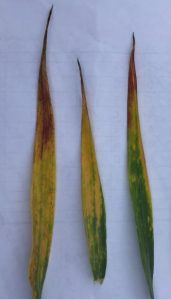Barley Yellow Dwarf is an economically important viral disease of small grains: wheat, barley, oats, and triticale. The yield losses may vary year to year, and may range from 5 to 25 percent, depending upon the weather conditions. Mild winters favor buildup of large aphid populations in early-planted wheat. The causal organism is Barley Yellow Dwarf Virus (BYDV), a Luteovirus transmitted by aphids.
Symptoms
The typical symptom of BYDV, as the name suggests, is yellowing of leaves that starts from the tip and progresses towards the base. The yellow color changes to Purple and red, as disease develops. Severe infection leads to stunting of plants. Oftentimes the flag leaves of infected plant stand out prominently as a reddish flags. The symptoms of BYDV may often be confused with nutrient deficiency or leaf streak mosaic virus. The disease occurs in patches in the field indicating the area of infestation by aphids, as compared to mineral deficiency, which is present more or less uniformly in the field. Aphid vectors may be visible on the plants infected with BYDV. Unlike, leaf streak mosaic virus, BYDV does not have a distinct mosaic pattern on the leaves. Definitive confirmation of BYDV can be done by ELISA tests.

Vector
Four main aphid vectors for BYDV are the oat birdcherry aphid (Rhoplasiphum padi), the corn leaf aphid (R. maidis), the English grain aphid (Sitobion avenae), and the greenbug (Schizaphis graminum). Aphids feeding on the infected plants acquire the viruses from the sap, and serve as carriers of BYDV throughout their lives.
Disease Cycle
The disease starts when aphids carrying BYD viruses feed on the sap of the plants. In the process, the viruses are discharged into the phloem of the plants. Symptoms appear approximately 14 days after infection. In mild winters or warm fall season, the viruses may persist in wild grass hosts or volunteer small grains. It can also be reintroduced each year from distant locations by virus-carrying aphids. Optimum temperatures for disease development are 60-77 oF. Symptoms are not visible at temperatures above 86 oF. Weather conditions that are favorable for both the small grain crops and aphids may lead the disease to an epidemic scale.
Management
- Planting dates: As warm fall temperatures favor aphid growth, winter varieties should be planted late in the season. Delaying planting of crops within the recommended fall planting date range until aphid populations decline will minimize the risk of yellow dwarf.
- Resistant cultivars: Use of resistant or tolerant varieties is an important strategy to reduce BYDV incidences. Good resistant varieties are known in barley and oats, but not in wheat. However, commercial wheat varieties are known to vary in their response to BYDV. Seed dealers can be a good source of information on resistance of their varieties.
- Weed management: Volunteer wheat, barley and oats, as well as perennial wild grasses serve as sources of viruses for the next crops. They should be managed to control BYDV in successive crops.
- Chemical control: Fungicides can not control BYDV and should not be used for it. Seed treatments with systemic insecticides such as Gaucho and Cruiser are costly but effective in aphid control. Contact insecticides have short window of effectiveness, and therefore are not advisable to control BYDV.
